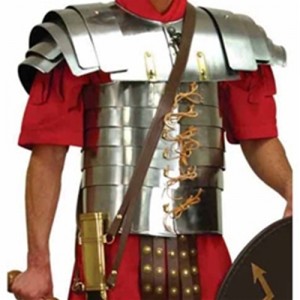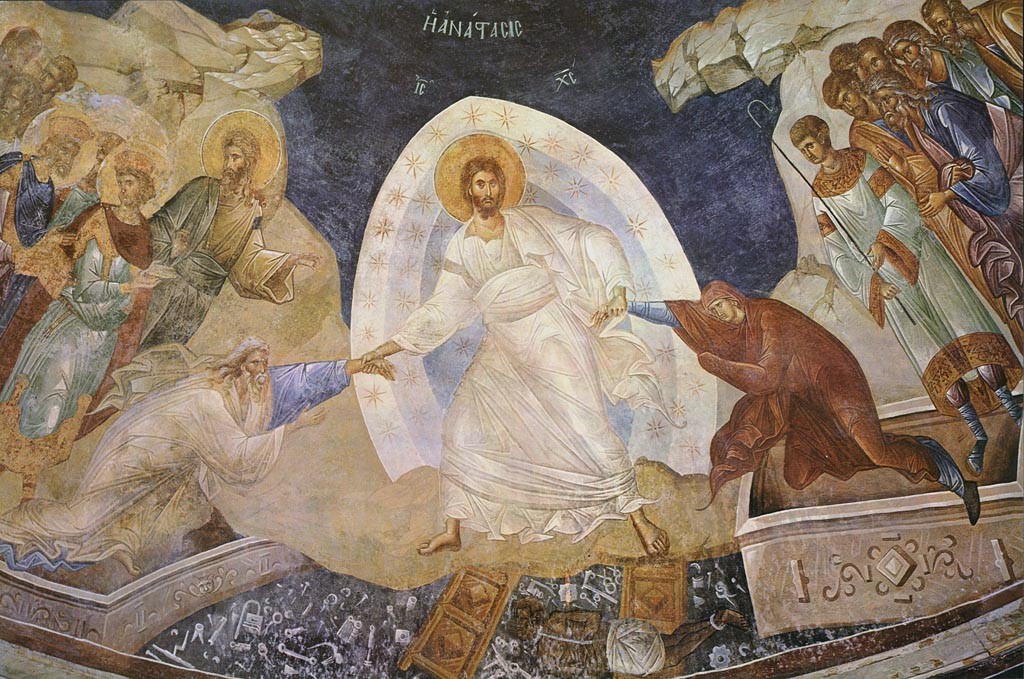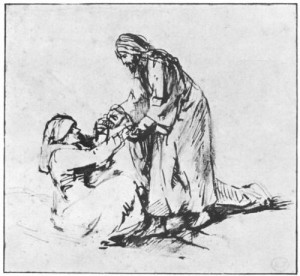====================
A sermon offered on Thirteenth Sunday after Pentecost (Proper 16B, Track 1, RCL), August 23, 2015, to the people of St. Paul’s Episcopal Church, Medina, Ohio, where Fr. Funston is rector.
(The lessons for the day are 1 Kings 8:1,6,10-11,22-30,41-43; Psalm 84; Ephesians 6:10-20; and John 6:56-69. These lessons may be found at The Lectionary Page.)
====================
 In the Education for Ministry program, the first year is spent reading the Old Testament, parts of which can be as dull as dirt! There are those long lists of genealogies, long catalogues of tribes and families, the lengthy and detailed instructions for making and erecting the tabernacle that the Hebrews carried along with them in the desert and, of course, a description of the Temple which Solomon built. In our EfM group, we sort of got into a habit of not reading those parts, of just acknowledging they were there but sort of skipping lightly over them. But it is there, earlier in the First Book of Kings from which our First Lesson is taken, a description of the building in which, in today’s lesson, Solomon places the Ark of the Covenant. Solomon’s Temple (the “First Temple”) was massive; it wasn’t really very big, but it was solid and substantial. It was built of huge blocks of solid stone; it had support beams made of whole cedar trees; it had immense fixtures and columns made of solid bronze and gold. In a word, it was a fortress!
In the Education for Ministry program, the first year is spent reading the Old Testament, parts of which can be as dull as dirt! There are those long lists of genealogies, long catalogues of tribes and families, the lengthy and detailed instructions for making and erecting the tabernacle that the Hebrews carried along with them in the desert and, of course, a description of the Temple which Solomon built. In our EfM group, we sort of got into a habit of not reading those parts, of just acknowledging they were there but sort of skipping lightly over them. But it is there, earlier in the First Book of Kings from which our First Lesson is taken, a description of the building in which, in today’s lesson, Solomon places the Ark of the Covenant. Solomon’s Temple (the “First Temple”) was massive; it wasn’t really very big, but it was solid and substantial. It was built of huge blocks of solid stone; it had support beams made of whole cedar trees; it had immense fixtures and columns made of solid bronze and gold. In a word, it was a fortress!
But, as Solomon says in his public prayer in today’s Old Testament lesson, God doesn’t really need a fortress: “Will God indeed dwell on the earth? Even heaven and the highest heaven cannot contain you, much less this house that I have built!” Earthly buildings cannot contain God and God certainly has no need of the protection massive stone walls can provide.
No, the Temple was not built for God; the Temple was built for human beings, for the Israelites. It is the place which serves as a focus for their devotion to the Almighty; it is the place where they will offer sacrifices and toward which they will face when they pray. So Solomon beseeches God, “Hear the plea of your servant and of your people Israel when they pray toward this place; O hear in heaven your dwelling place; heed and forgive.” And Solomon goes even further and asks that God also hear the prayers of foreigners: “Likewise . . . when a foreigner comes and prays toward this house, then hear in heaven your dwelling place, and do according to all that the foreigner calls to you.”
The Temple was an earthly reminder of God’s Law; it was the resting place of the Ark of the Covenant, called the footstool of God by David. In the 28th Chapter of the First Book of Chronicles, David calls his court officers and his designated heir, Solomon, to an assembly and says to them, “I had planned to build a house of rest for the ark of the covenant of the Lord, for the footstool of our God; and I made preparations for building.” (v. 2, NRSV) He then gives his plans for the Temple to Solomon. In Psalm 132, the Psalmist (traditionally David) makes a similar reference when he says, “Let us go to God’s dwelling place; let us fall upon our knees before his footstool.” (v. 7, BCP)
The lexicons tell us that uses of this term footstool are metaphorical and symbolic of subjection to God as universal Lord. However, the term always reminds me of my grandmother Edna Funston who was a nurse. She and my grandfather lived only about four blocks from the hospital where she was employed, so she would walk to and from work everyday. After spending her days, like most nurses do, on her feet, she would walk those four blocks and then sit for a while with her feet up, resting them on a footstool that sat in front of her favorite chair. When I hear of God’s footstool, I picture God putting his feet up after a long walk. It reminds me of that passage from the Book of Genesis in which Adam and Eve, having violated God’s instructions by eating the fruit of the tree of knowledge, “heard the sound of the Lord God walking in the garden at the time of the evening breeze” and hid themselves. (Gen 3:8) It reminds me also of that passage in the Prophet Micah: “What does the Lord require of you but to do justice, and to love kindness, and to walk humbly with your God?” (Mic 6:8)
The Temple was an earthly reminder of God’s Law which requires God’s people to do justice, and to love kindness, and to walk humbly with our God. Several generations after the Temple was built, God’s people were doing anything but . . . and the Prophet Isaiah portrayed God as less than pleased by that. Isaiah prophesied:
Justice is turned back, and righteousness stands at a distance; for truth stumbles in the public square, and uprightness cannot enter. Truth is lacking, and whoever turns from evil is despoiled. The Lord saw it, and it displeased him that there was no justice. He saw that there was no one, and was appalled that there was no one to intervene; so his own arm brought him victory, and his righteousness upheld him. He put on righteousness like a breastplate, and a helmet of salvation on his head; he put on garments of vengeance for clothing, and wrapped himself in fury as in a mantle. (Isa 59:14-17)
Several centuries after Isaiah, the writer of the Book of Wisdom would offer an apocalyptic vision of the last judgment in similar terms:
The Lord will take his zeal as his whole armor, and will arm all creation to repel his enemies; he will put on righteousness as a breastplate, and wear impartial justice as a helmet; he will take holiness as an invincible shield, and sharpen stern wrath for a sword, and creation will join with him to fight against his frenzied foes. (Wis 5:17-20
The Letter to the Ephesians (which claims to have been written by Paul but is generally believed to have been written by one of his disciples shortly after his death, perhaps from notes drafted or dictated by Paul) makes use of these ancient armor and weapon metaphors in a new and startling way.
Let’s take a moment to reflect on the audience to whom this letter was initially addressed, the church at Ephesus, a small body of believers living as a minority in a hostile environment. Their commitment to Christ set them conspicuously at odds with their neighbors, perhaps even with some in their own families. They were regarded with suspicion, even considered troublemakers and atheists, by their neighbors because they refused to join in the municipal cult of the hunter goddess Artemis whose worship was an important commercial enterprise for the city. They were regarded as troublemakers and atheists by the Roman empire because they refused to burn incense and pay tribute at the altars to the emperor. It is likely that they had had more than one encounter with the police, who were not merely the police; they were the Roman army.
So when the writer of the Letter to the Ephesians borrows the armor imagery of Isaiah and the Book of Wisdom, although “the concrete details of the armor are biblical, not Roman, the audience probably envisaged the fully armed Roman soldier when they heard these words.” (NIB, Vol. XI, page 460) It is as if someone today were to write to a congregation in (for example) Ferguson, Missouri, and say: “Put on the bulletproof vest of righteousness and the night-vision goggles of truth. Take up the automatic rifle of the Spirit.” And that is how we need to hear these metaphors, too – as shocking and disturbing and counter-cultural. It violated their, and should violate our, expectations of what a comforting pastoral letter should say, and thus their eyes were opened, and our eyes should be, to the darkness of the present reality.
Of course, whether one uses the ancient weapons of the original or modernizes the imagery, the use is metaphorical. As the Letter reminds its initial readers and us, “our struggle is not against enemies of blood and flesh, but against the rulers, against the authorities, against the [world] powers of this present darkness, against the spiritual forces of evil.” This is not a call to armed revolution; it is not a call to man the barricades and overthrow the government. Although this text has been used shamefully and wrongly to justify violence and oppression, it is not a call for the followers of Jesus to become some sort of Christian ISIS.
No! We are not called to actually take up arms. The armor we are to don is that which these metaphors represent: truth, righteousness, peace, faith, holiness, impartial judgment, and the word of God (which is not the Bible, the Word of God is Jesus!). We so by constantly preparing ourselves. Earlier in the Letter, the writer admonished the Ephesians to utilize their gifts as apostles, prophets, evangelists, pastors, and teachers to build up the church and equip one another for the work of ministry (4:11-12), to sing psalms and hymns together, to pray and give thanks (5:19-20). The same is true for us; “believers [today] must hear sermons, read scripture, talk with other Christians, engage in regular prayer, sing the praises of God, and so on.” (NIB, pg 403) Our formation as members of the Body of Christ, our preparation to withstand the “powers of this present darkness” and “the spiritual forces of evil” must be continuous.
We may skip over the details of its construction because we know that God didn’t need the Temple, but the truth is that the Israelites did. We may choose not read the full description because we know that God doesn’t need a fortress, but the truth is that we do. The Stoic philosopher Seneca taught that the soul of a wise person is fortified by reason and secure virtue. He wrote, “The walls which guard the wise [person] are safe from both flame and assault, they provide no means of entrance, are lofty, impregnable, godlike.” (De Constantia Sapientis [On the Constancy of the Wise Man], 6.8) We need that spiritual fortress!
In the same way, God really has no need of the metaphorical armor and weapons described in Isaiah, the Book of Wisdom, and the Letter to the Ephesians, but we do. Clothed with “the whole armor of God,” we will “be able to stand against the wiles of the devil,” and fed with “the bread that came down from heaven . . .[we] will live forever.”
Let us pray:
Almighty and merciful God, in your goodness keep us, we pray, [protected by your armor] from all things that may hurt us [and nourished by the Body and Blood of your Son], that we, being ready both in mind and body, may accomplish with free hearts those things which belong to your purpose; through Jesus Christ our Lord, who lives and reigns with you and the Holy Spirit, one God, now and for ever. Amen. (Collect 2 [with addition], BCP 1979, pg. 228)
====================
A request to my readers: I’m trying to build the readership of this blog and I’d very much appreciate your help in doing so. If you find something here that is of value, please share it with others. If you are on Facebook, “like” the posts on your page so others can see them. If you are following me on Twitter, please “retweet” the notices of these meditations. If you have a blog of your own, please include mine in your links (a favor I will gladly reciprocate). Many thanks!
====================
Father Funston is the rector of St. Paul’s Episcopal Church, Medina, Ohio.

 The four evangelists are traditionally represented by iconic depictions of the emphasis of their gospels. John, whose gospel is the longest and most different of the four tellings of Jesus’ story, is represented by an eagle because he emphasizes the divinity of Christ. Matthew, on the other hand, begins his gospel with Jesus’ genealogy and emphasizes the humanity of the Savior, so he is represented by a man. Luke emphasizes the sacrificial nature of Jesus’ ministry and mission; thus, he is represented by an ox or bull (often winged), the sort of animal offered in the Temple.
The four evangelists are traditionally represented by iconic depictions of the emphasis of their gospels. John, whose gospel is the longest and most different of the four tellings of Jesus’ story, is represented by an eagle because he emphasizes the divinity of Christ. Matthew, on the other hand, begins his gospel with Jesus’ genealogy and emphasizes the humanity of the Savior, so he is represented by a man. Luke emphasizes the sacrificial nature of Jesus’ ministry and mission; thus, he is represented by an ox or bull (often winged), the sort of animal offered in the Temple. “Life is a banquet, and most poor suckers are starving to death!”
“Life is a banquet, and most poor suckers are starving to death!”  After I did my first sermon-prep read through of this morning’s gospel I thought, “There are two stories here.” Then I thought, “No, there are three.” And then I realized that there are really more stories here than I can count.
After I did my first sermon-prep read through of this morning’s gospel I thought, “There are two stories here.” Then I thought, “No, there are three.” And then I realized that there are really more stories here than I can count.  Tonight we gather once again to celebrate a memory, the memory of the birth of Christ, the Christ who is about to be born again as he is every year. We don’t really know if he was born at this time of the year; in fact, most scholars agree he wasn’t. But that doesn’t matter. It isn’t the date that we celebrate; it is his birth, then and in our lives each time we remember.
Tonight we gather once again to celebrate a memory, the memory of the birth of Christ, the Christ who is about to be born again as he is every year. We don’t really know if he was born at this time of the year; in fact, most scholars agree he wasn’t. But that doesn’t matter. It isn’t the date that we celebrate; it is his birth, then and in our lives each time we remember.
 When Philip told Nathanael that he had found the Messiah and that he was the son of a carpenter from Nazareth, Nathanael’s immediate response was, “Can anything good come from Nazareth?” (Jn 1:46). Obviously Nazareth had a reputation, and not a good one. I often wonder if, as Jesus was making his way through the Holy Land, especially early in his ministry when he wasn’t well-known, people would ask him, “What was it like growing up in Nazareth?”
When Philip told Nathanael that he had found the Messiah and that he was the son of a carpenter from Nazareth, Nathanael’s immediate response was, “Can anything good come from Nazareth?” (Jn 1:46). Obviously Nazareth had a reputation, and not a good one. I often wonder if, as Jesus was making his way through the Holy Land, especially early in his ministry when he wasn’t well-known, people would ask him, “What was it like growing up in Nazareth?”

